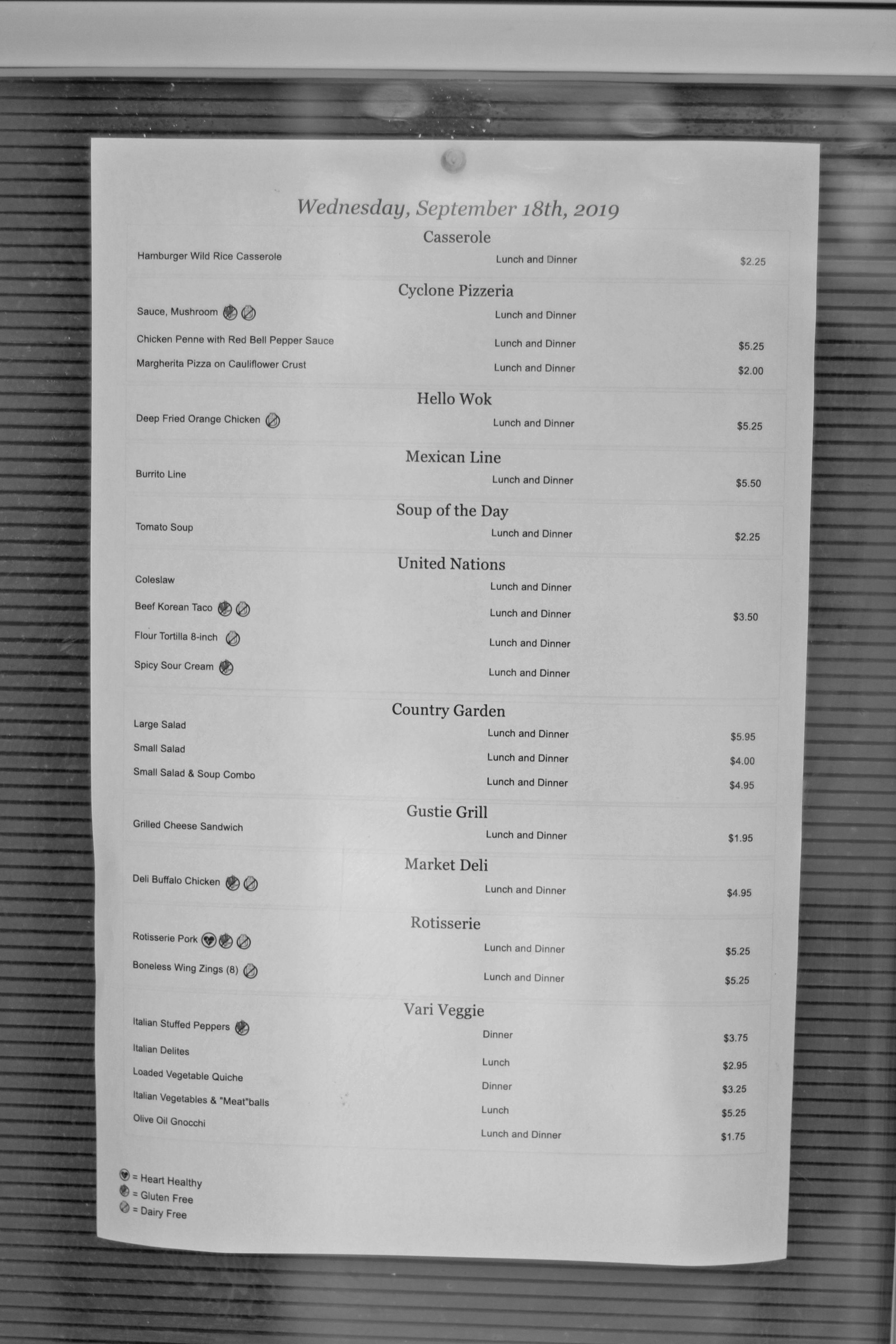As students settled into a new school year, challenging classes made for howling stomachs. The familiar aroma of mashed potatoes was welcoming and fresh fruit can never be passed up on a September afternoon. However, as students walked confidently through the checkout line for the first time this fall, they may have noticed an increase in prices—their mashed potatoes are no longer as familiar as they were in the spring.
Shari Jacobson, Purchasing Manager for Dining Services, describes the balance of pricing food items and considering students’ interests as a “juggling act”. Every price increase has a story behind it. As Jacobson places the daily food order, she must assess the affordability, likability and environmental impact of each item.
Students are beginning to lean toward healthier food options—that is, food options that are healthier for both their bodies and for the planet.
“Distributors know Millenials want food that is responsibly grown,” Jacobson said.
With this knowledge, distributors are focusing on providing cruelty-free meats and carefully grown vegetables with fewer damaging chemicals. Students are willing to pay more for meat that has been cared for.
But as Caf products are making students’ carbon footprints smaller, they are leaving a larger gap in students’ wallets.
Another large impact of increased prices in the Caf is disposable equipment, such as to-go containers and pre-packaged food.
To-go containers and pre-packaged foods are expensive to begin with, and “Gustavus budgets money for everything to be compostable,” Jacobson said.
Even though students at Gustavus value compostability and the planet’s well-being, the student demand for choosing disposable equipment over GustieWare has sky-rocketed, requiring Jacobson to place more orders of disposable items, which tremendously shifts the balance of prices between Caf items.
Jacobson does her best to promote affordability in the Caf. As students begin to request non-meat proteins as much as real meat proteins, both prices must raise to balance the expense of non-meat proteins. Sweet potatoes and regular potatoes are the same price when ringing through the register, but in Jacobson’s orders, sweet potatoes are twice the price of regular potatoes.
Everything students can find in the Caf has been calculated to support all students’ preferences at the lowest cost possible in order to encourage healthy habits and environmentally sound choices.
“Our goal is never to make a profit,” Jacobson said.
In fact, as many other universities hire vendors to serve meals on campus (i.e. Chick-fil-A, Taco Bell), by hiring our own staff, Gustavus saves money and values the employees of Dining Services by providing equal benefits to every other employee on campus. Vendors of popular fast-food chains seek profit in sales. Although students may crave a Baja Blast on a Monday during finals week, it is much more beneficial to students, staff and the environment to hire our own employees, order our own menus and continue promoting environmentally sound choices.
As the climate crisis is showing alteration in our weather predictions, it also contributes to the unpredictability of price changes in food items. As fewer fish are available to be caught at sea, seafood prices continue to rise. Although the demand for seafood is fairly consistent, the supply of seafood is not.
As students and distributors raise consciousness of green-house gasses emitted by excess meat production, prices of non-meat and real meat proteins are expected to rise as students prefer non-meat proteins, which cost more to produce.
Crop seasons of fruits and vegetables are threatened by unstable climates.
“We don’t know what’s going to happen,” Jacobson said in regards to how the climate crisis affects the Caf’s food supply.
The ultimate question is this: What do Gusties value? The Caf staff have become attuned to the answer: Gusties value the environment, their bodily health, and affordability. To do what is environmentally sound for the planet can be costly, but Gusties have proven that the future of the environment is worth it. “We want to do the right thing, even if it means paying a little extra,” Jacobson said.
Here’s what we as Gusties can do in the Caf to help the planet and relax our meal balances.
- Use GustieWare or eat in the Caf. To-go containers cost fifty cents each. A month into the school year, those fifty cent boxes begin to add up. Save yourself money (and save the environment some resources) by avoiding to-go boxes when possible.
- Keep making environmentally sound choices. Not only is it good for your body, but extremely beneficial to Mother Earth. In the long run, cost doesn’t matter: what matters is the sustainability of the planet.
- Continue being Gusties. Gusties care for issues bigger than themselves. This includes climate change, which continues to affect us every day. Anything Gusties can do to lessen the burden of unnecessary resources will benefit our planet.
